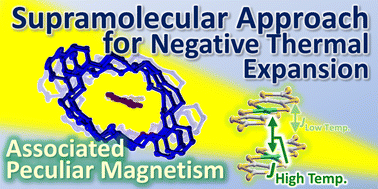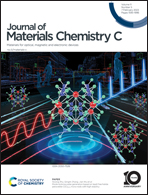Uniaxial negative thermal expansion induced by molecular rotation in a one-dimensional supramolecular assembly with associated peculiar magnetic behavior†
Abstract
In general, negative thermal expansion (NTE) is entropy-driven. We have developed the alternative approach for achieving uniaxial NTE in a molecular crystal induced by supramolecular deformation and molecular rotation, along with peculiar magnetic responses. In the crystal of (pyridazinium+)2(dibenzo[24]crown-8)3[Ni(dmit)2]−2 (1) (dmit = 1,3-dithiole-2-thione-4,5-dithiolate), pyridazinium was included within the dibenzo[24]crown-8, and formed a one-dimensional columnar structure parallel to the a-axis. This column elongates along the a-axis, and shrinks along the b-axis. This provides space for the pyridazinium to rotate, which promotes further NTE above 183 K. In addition, the [Ni(dmit)2]− forms a dimer, where the intradimer magnetic exchange interaction (J) increases with increasing temperature. The modified singlet–triplet thermal excitation model, where J increased with increasing temperature, can be fitted to the temperature-dependent magnetic susceptibility of 1. A deviation from the model was observed above 180 K, which is attributed to the structural changes within the [Ni(dmit)2]− dimer, caused by the molecular rotation of the pyridazinium moiety.



 Please wait while we load your content...
Please wait while we load your content...